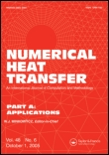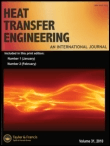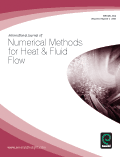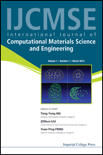
Special Topics & Reviews in Porous Media-An International Journal
Scope & Guideline
Exploring Innovations in Porous Media Science
Introduction
Aims and Scopes
- Fluid Dynamics in Porous Media:
The journal emphasizes studies on fluid flow through porous structures, exploring various fluid types including Newtonian, non-Newtonian, and nano-fluids. - Heat Transfer Mechanisms:
Research on thermal behavior and heat transfer phenomena in porous media is a core focus, encompassing studies on thermal stability, convection, and radiation effects. - Mass Transfer and Chemical Reactions:
The journal publishes works on mass transfer processes, including diffusion and chemical reactions occurring within porous materials, highlighting their implications in various applications. - Mathematical and Computational Modeling:
A significant portion of the research employs advanced mathematical techniques and computational simulations to investigate complex phenomena in porous media. - Multi-Phase Flow Dynamics:
The journal covers studies on multi-phase flow interactions within porous structures, addressing challenges in areas such as enhanced oil recovery and environmental engineering. - Applications in Engineering and Environmental Sciences:
Research contributions often relate to practical applications, including energy systems, water management, and materials science, showcasing the real-world relevance of porous media studies.
Trending and Emerging
- Nano-Fluid Dynamics:
There is an increasing interest in the behavior of nano-fluids in porous media, highlighting their applications in enhanced heat transfer and energy efficiency. - Electro-Magnetic Effects on Fluid Flow:
Research exploring the impact of magnetic fields on fluid dynamics within porous materials is an emerging theme, indicating a growing interest in magnetohydrodynamics. - Thermal Non-Equilibrium Models:
Studies addressing local thermal non-equilibrium conditions in porous media are on the rise, reflecting the complexity of real-world applications where heat transfer cannot be simplified. - Bioconvection and Microorganism Interaction:
Research focusing on the effects of microorganisms and bioconvection in porous media is gaining attention, particularly in environmental and biomedical applications. - Sustainable and Renewable Energy Applications:
The journal is seeing a surge in studies related to the application of porous media in sustainable energy solutions, such as solar energy systems and heat exchangers. - Advanced Computational Techniques:
The use of sophisticated computational methods, including machine learning and advanced numerical simulations, is becoming more prevalent, enhancing the predictive capabilities of fluid flow in porous media.
Declining or Waning
- Traditional Fluid Dynamics Studies:
Research focusing solely on classical fluid dynamics in porous media without integration of advanced materials or methods has decreased, signaling a trend towards more complex and hybrid systems. - Basic Heat Transfer Analysis:
Studies that only address fundamental heat transfer principles in porous media, without consideration of advanced effects like thermal non-equilibrium or nano-fluid interactions, are less frequently published. - Single-Phase Flow Investigations:
There is a noticeable reduction in publications solely focused on single-phase fluid flow, as the field increasingly emphasizes multi-phase interactions and complex fluid behaviors. - Static Models without Dynamic Considerations:
Research that relies on static models and does not incorporate dynamic factors such as time-dependent changes or variable conditions has become less prevalent. - Simplistic Chemical Reaction Models:
The journal has seen fewer contributions focusing on simplistic chemical reaction models, suggesting a shift towards more complex reactions incorporating real-world applications.
Similar Journals

Thermal Science
Fostering collaboration in the pursuit of thermal innovations.Thermal Science is an esteemed open-access journal published by the Vinca Institute of Nuclear Sciences in Serbia. With a rich focus on the field of thermal science, this journal has established itself as a vital resource for researchers and professionals interested in the dynamics of energy, renewable energy systems, and environmental sustainability. Since its inception in 2001, Thermal Science has dedicated itself to disseminating high-quality research that addresses the challenges of contemporary thermal technologies. The journal has converged its years of publication from 2007 to 2024 and currently holds a Q4 ranking in the category of Renewable Energy, Sustainability, and the Environment, with a Scopus rank of #172 out of 270, placing it in the 36th percentile. This makes it a crucial platform for sharing innovations and findings that contribute to the development of sustainable energy solutions. With open access options available, Thermal Science ensures that knowledge is readily accessible, fostering collaboration and advancement in this critical field.

Interfacial Phenomena and Heat Transfer
Innovating Solutions for Fluid Flow and Chemical ProcessesInterfacial Phenomena and Heat Transfer is a leading academic journal published by BEGELL HOUSE INC that has rapidly established itself as an essential resource for scholars and industry experts in the fields of engineering, fluid flow, and chemical processes. With an ISSN of 2169-2785 and E-ISSN 2167-857X, this journal focuses on the critical interdisciplinary aspects of heat transfer and interfacial phenomena, offering insights that span across mechanical engineering, chemical engineering, and physical sciences. Despite its relatively recent inception in 2017, it has garnered respectable recognition, with a 2023 Scopus rank placing it in the Q3 category within the disciplines of Engineering (miscellaneous) and Fluid Flow and Transfer Processes, making it a pertinent publication for those interested in cutting-edge research. As researchers and professionals navigate the complexities of interfacial dynamics, Interfacial Phenomena and Heat Transfer serves as a pivotal platform, publishing high-quality, peer-reviewed articles that aim to advance knowledge and stimulate further investigation in this increasingly vital domain.

ASME Journal of Heat and Mass Transfer
Transforming Research into Real-World SolutionsASME Journal of Heat and Mass Transfer, published by the renowned American Society of Mechanical Engineers (ASME), is a pivotal journal in the fields of mechanical engineering and materials science. With its ISSN 2832-8450 and E-ISSN 2832-8469, this journal aims to disseminate high-quality research focused on the principles and applications of heat transfer and mass transfer phenomena. Despite its recent launch, having converged from 2023 to 2024, it has quickly established a significant presence in the academic community, holding respectable rankings within the Scopus database across various categories—including a 66th percentile rank in Mechanical Engineering. The journal endeavors to foster innovation and collaborative research that advance the frontiers of knowledge in thermal sciences, making it an essential resource for researchers, practitioners, and students keen on exploring the challenges and developments in heat and mass transfer technologies. The journal also embraces an open-access model, ensuring that leading research reaches a broader audience and contributes to global knowledge sharing.

NUMERICAL HEAT TRANSFER PART A-APPLICATIONS
Elevating the discourse in numerical heat transfer and condensed matter physics.NUMERICAL HEAT TRANSFER PART A-APPLICATIONS, published by TAYLOR & FRANCIS INC, serves as a premier outlet for cutting-edge research in the domains of numerical analysis and condensed matter physics. With an ISSN of 1040-7782 and an E-ISSN of 1521-0634, this esteemed journal has steadily maintained its influence in the academic community since its establishment in 1989, continuing its publication into 2024. Currently ranked in the Q2 quartile for both Condensed Matter Physics and Numerical Analysis, it stands as a vital resource for researchers committed to advancing computational methodologies and applications. The journal's Scopus rankings reflect its growing impact, particularly in mathematics, where it is placed in the top 26% of its category. Although not an open-access journal, its comprehensive research articles and detailed applications foster innovation and collaboration, making it essential for professionals and students aiming to deepen their understanding of thermal transfer phenomena through numerical techniques. This journal not only bridges theory and application but also propels forward the field of heat transfer.

HEAT AND MASS TRANSFER
Bridging gaps in knowledge with cutting-edge research.HEAT AND MASS TRANSFER is a prestigious peer-reviewed journal published by Springer, dedicated to advancing the understanding of thermal and mass transfer phenomena in various physical and engineering contexts. With an ISSN of 0947-7411 and an E-ISSN of 1432-1181, this journal has established itself as a key platform for researchers and professionals in the fields of Condensed Matter Physics and Chemical Engineering, achieving a commendable Q2 ranking in both categories as of 2023. The journal also holds impressive positions on Scopus, being ranked #147 out of 434 in Condensed Matter Physics and #33 out of 96 in Fluid Flow and Transfer Processes, both in the 66th percentile. Covering innovative research and practical applications from its inception in 1995 through to 2024, HEAT AND MASS TRANSFER is crucial for those aiming to deepen their knowledge and stay updated on the latest advancements in heat and mass transfer research. While the journal does not offer open access, its rigorous content is essential for researchers seeking to contribute to and benefit from scholarly discourse in this vital area of science.

HEAT TRANSFER ENGINEERING
Connecting theory with practice in heat transfer engineering.HEAT TRANSFER ENGINEERING is a leading international journal published by Taylor & Francis Inc, dedicated to advancing the field of heat transfer and thermal engineering. With a strong focus on the key aspects of Condensed Matter Physics, Fluid Flow and Transfer Processes, and Mechanical Engineering, this journal covers a comprehensive range of topics from experimental studies to theoretical analysis, aiming to foster innovative research and practical applications. Since its inception in 1979 and continuing through 2024, the journal has established itself as an essential resource for researchers and industry professionals alike, reflected in its solid rankings within Scopus—holding a Q2 quartile classification in multiple engineering disciplines. Although not open access, the journal ensures broad accessibility through institutional subscriptions, making cutting-edge research readily available. With its rigorous peer-review process and commitment to quality, HEAT TRANSFER ENGINEERING plays a crucial role in shaping the future of thermal management solutions and engineering practices.

HEAT TRANSFER RESEARCH
Advancing the Frontiers of Thermal ScienceHEAT TRANSFER RESEARCH is a leading academic journal published by Begell House Inc that focuses on the dynamic and evolving fields of heat transfer, fluid flow, and mechanical engineering. With an ISSN of 1064-2285 and an E-ISSN of 2162-6561, this journal serves as a critical platform for researchers and professionals seeking to disseminate innovative findings and advancements in these interrelated disciplines. Covering converged years from 1992 to 2024, HEAT TRANSFER RESEARCH has established its impact in the academic community, achieving a 2023 ranking of Q3 in Condensed Matter Physics and Q2 in Fluid Flow and Transfer Processes. It currently occupies a percentile rank ranging from 44th to 54th across several Scopus categories, underscoring its relevance and contribution to the scientific discourse. While Open Access options are not available, the journal remains committed to providing high-quality research and insights that shape the future of thermal sciences. Accessible to both seasoned professionals and aspiring students, HEAT TRANSFER RESEARCH is indispensable for anyone looking to stay ahead in the ever-changing landscape of engineering and applied physics.

INTERNATIONAL JOURNAL OF NUMERICAL METHODS FOR HEAT & FLUID FLOW
Advancing the Frontiers of Heat and Fluid Dynamics.INTERNATIONAL JOURNAL OF NUMERICAL METHODS FOR HEAT & FLUID FLOW, published by EMERALD GROUP PUBLISHING LTD, is a premier platform dedicated to advancing the field of numerical methods applied to heat and fluid flow analysis. With an ISSN of 0961-5539 and an E-ISSN of 1758-6585, this journal has been a vital resource since its inception in 1991, covering cutting-edge research right up to 2024. It is highly regarded within various disciplines, as evidenced by its impressive ranking in the 2023 Scopus categories, which places it in the Q1 tier for Computational Mechanics and a Q2 tier for Aerospace Engineering and Mechanical Engineering. This authoritative journal holds significant importance for researchers, professionals, and students who are keen on expanding their knowledge and addressing challenges in thermal and fluid dynamics through innovative computational techniques. Although the journal does not provide Open Access options, its rigorous peer-review process and high-impact publication standards ensure that it remains an essential tool for those involved in engineering advancements and applied mathematics.

International Journal of Computational Materials Science and Engineering
Pioneering research for a sustainable materials future.International Journal of Computational Materials Science and Engineering (ISSN: 2047-6841; E-ISSN: 2047-685X) is a pioneering academic journal published by World Scientific Publishing Co. Pte Ltd, based in Singapore. With a dedicated focus on the intersection of computational techniques and materials science, the journal serves as a crucial platform for disseminating cutting-edge research and developments from both theoretical and practical perspectives. The journal's rigorous peer-review process and commitment to high-quality submissions ensure the publication of influential articles that can significantly impact their fields of study. As of 2023, the journal holds a Q4 ranking in Computer Science Applications and Q3 in Materials Science (miscellaneous), along with notable rankings in other categories such as Mechanics of Materials and Numerical Analysis. Although not Open Access, it facilitates a rich repository of knowledge essential for researchers and professionals aiming to advance their work in computational methods and materials engineering. With converged years from 2012 to 2024, the journal continues to build on its reputation by fostering interdisciplinary collaborations and innovations.

Archives of Thermodynamics
Elevating Understanding of Energy TransformationsArchives of Thermodynamics is a reputable journal dedicated to the field of thermodynamics, published by the esteemed POLISH ACADEMY OF SCIENCES. With a robust history since its inception in 2003, this journal serves as a critical platform for disseminating high-quality research aimed at advancing knowledge and technology in thermodynamic systems and processes. Recognized for its contribution to the field, it holds a Q3 ranking in the Physics and Astronomy (miscellaneous) category as of 2023, with a respectable Scopus rank of #148 out of 243, placing it within the 39th percentile. Although it follows a traditional access model, the journal's commitment to scholarly excellence ensures that researchers, professionals, and students alike can benefit from its rich archives and ongoing discussions within the scientific community. Situated in Warsaw, Poland, the journal not only reflects a regional dedication to scientific progress, but also engages with global audiences interested in the evolving landscape of thermodynamic research.